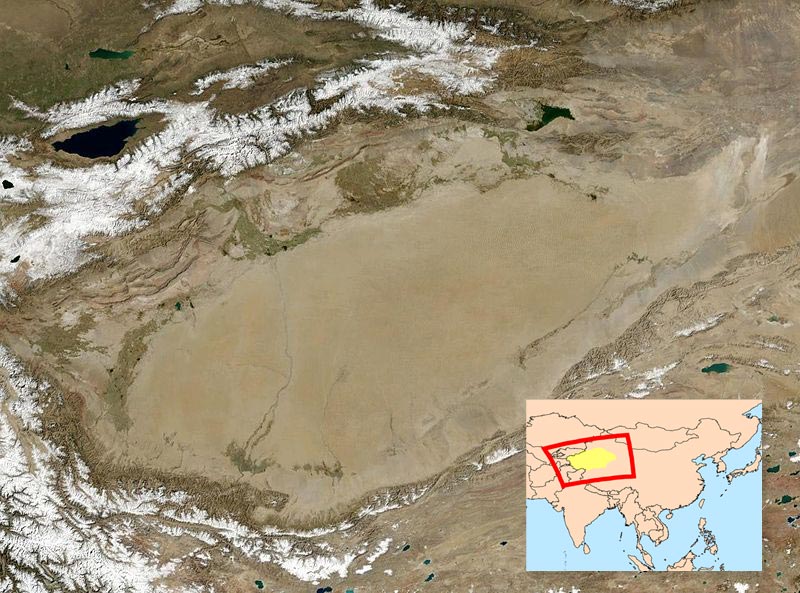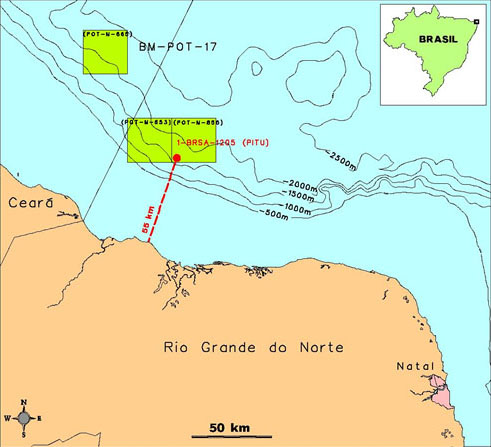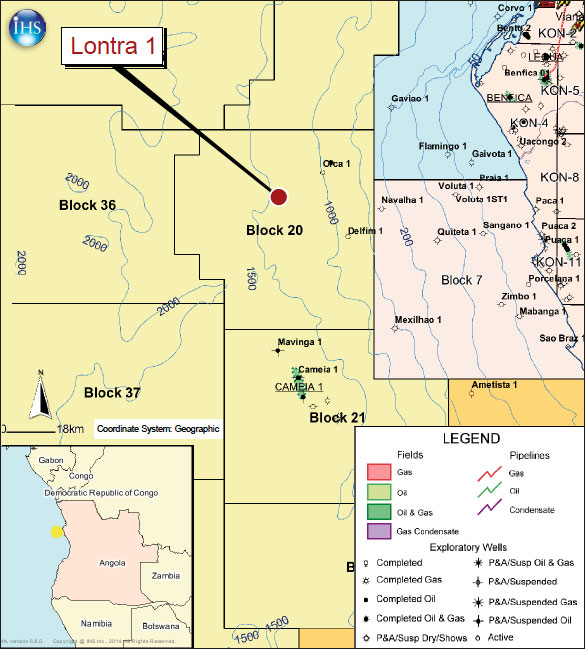China: Extending Deep Objective Campaign
 The Tarim Basin, situated in north-west China, is considered one of the most petroliferous provinces in the country. Source: NASA/wikipediaPetroChina claimed an important gas discovery with a wildcat drilled on the Keshen 9 prospect in the Kelasu structure belt in the Kuche depression. Drilled to a total depth of 7,580m, some 200m short of target depth, Keshen 9 flowed 39.89 MMcfpd from the interval 7,552 – 7,580m in the Bashijiqike Cretaceous Formation. The bottom hole temperature was recorded as high as 179°C and pressure was 127.68 Mpa at 7,552m. The company has yet to comment on the resource potential of this structure.
The Tarim Basin, situated in north-west China, is considered one of the most petroliferous provinces in the country. Source: NASA/wikipediaPetroChina claimed an important gas discovery with a wildcat drilled on the Keshen 9 prospect in the Kelasu structure belt in the Kuche depression. Drilled to a total depth of 7,580m, some 200m short of target depth, Keshen 9 flowed 39.89 MMcfpd from the interval 7,552 – 7,580m in the Bashijiqike Cretaceous Formation. The bottom hole temperature was recorded as high as 179°C and pressure was 127.68 Mpa at 7,552m. The company has yet to comment on the resource potential of this structure.
Since 2008 when the company made the significant Keshen 2 gas discovery, the area has become established as a key gas exploration area in the Tarim Basin, which in 2010 had accumulative proven in-place reserves of about 5 Bb and 42 Tcfg, having confirmed the huge potential in the Kuche depression, now ranked as one of the most petroliferous provinces in China. A number of giant gas fields have been discovered in recent years in the deep reservoirs (6,000–8,000m) in the surrounding region, including the Dabei 1, Dabei 3, Keshen 1, Keshen 2 and Keshen 5 gas fields. These new discoveries are typical tight reservoirs with extremely low porosity and permeability. Compared with other similar tight reservoirs elsewhere, however, the gas saturation levels in the newly discovered reservoirs are exceedingly high (around 60–90%), comparable to that of conventional reservoirs. Keshen 9 follows this trend.
According to PetroChina, the company will produce 600 MMcfgpd by 2015 from the Keshen 1 and 2 area and 1.2 Bcfgpd from the wider Keshen area by 2020.
Brazil: First Potiguar Basin Deepwater Find
 First oil discovery in the deep waters of the Potiguar Basin, north-east Brazil? Source: PetrobrasWhile a resource estimate is yet to be established, Petrobras is claiming that its 1-BRSA-1205-RNS (1-RNS-158) wildcat in the POT-M-855 block, which is testing the Pitu prospect, has established an oil column and is thus the first oil discovery in the deep waters of the Potiguar Basin. Located in 1,731m of water, the well continues to drill towards a planned total depth of 5,028m. The oil column was confirmed through log data and fluid samples at a depth of around 4,150m. At the moment Petrobras is the operator of the concession with 80% stake and Petrogal Brasil S.A. holds the remaining 20%. However, due to the farm-out agreement in progress at the moment, and after obtaining the approval of the National Agency of Petroleum, Natural Gas and Biofuels (ANP), BP Energy do Brazil Ltda will join the consortium and interests of the partners in the block will be: Petrobras – 40%, BP – 40% and Petrogal – 20%.
First oil discovery in the deep waters of the Potiguar Basin, north-east Brazil? Source: PetrobrasWhile a resource estimate is yet to be established, Petrobras is claiming that its 1-BRSA-1205-RNS (1-RNS-158) wildcat in the POT-M-855 block, which is testing the Pitu prospect, has established an oil column and is thus the first oil discovery in the deep waters of the Potiguar Basin. Located in 1,731m of water, the well continues to drill towards a planned total depth of 5,028m. The oil column was confirmed through log data and fluid samples at a depth of around 4,150m. At the moment Petrobras is the operator of the concession with 80% stake and Petrogal Brasil S.A. holds the remaining 20%. However, due to the farm-out agreement in progress at the moment, and after obtaining the approval of the National Agency of Petroleum, Natural Gas and Biofuels (ANP), BP Energy do Brazil Ltda will join the consortium and interests of the partners in the block will be: Petrobras – 40%, BP – 40% and Petrogal – 20%.
The Potiguar Basin is situated on the north-east coast of Brazil. Located in an undrilled area of the basin, in the south-western corner of the block, this is the third wildcat Petrobras has drilled in its exploratory programme in the deepwater area of the Potiguar Basin and is described as a play-opener. This basin currently produces approximately 125,000 boepd, making it the third most important producing area in Brazil after the Campos and Santos Basins. The offshore fields are all in the nearshore area, and there is little exploration data and no production from the deepwater portion, which has water depths down to 3,000m.
Angola: Is Pre-salt Gas Prone?
 Lontra 1 discovery in the Northern Kwanza Basin. Source: IHSDescribed by Cobalt International Energy chief executive officer Joseph Bryant as a “discovery on a global scale”, the Lontra 1 discovery in Angola’s Block 20 makes it four out of four for the company, a remarkable start for its campaign in the Northern Kwanza Pre-Salt Basin. Drilled to a total depth of 4,195m, the well encountered 75m of net pay in a high quality reservoir and was announced as a discovery in October 2013. Recently re-entered for testing, the well encountered both a high liquids content gas interval and an oil interval, and flowed 2,500 bcpd and 39 MMcfgpd, rates significantly restricted by surface test facilities. The drill stem test was conducted in the high liquids content gas interval in order to acquire data on the flow capacity and fluid composition of this interval. The estimated cost for the well has reportedly increased from an initial estimate of US$160 million to US$233 million, making Lontra 1 one of Angola’s most expensive wildcats to date. The rig has been retained within Block 20 and is now drilling the Orca 1 wildcat, also a pre-salt test.
Lontra 1 discovery in the Northern Kwanza Basin. Source: IHSDescribed by Cobalt International Energy chief executive officer Joseph Bryant as a “discovery on a global scale”, the Lontra 1 discovery in Angola’s Block 20 makes it four out of four for the company, a remarkable start for its campaign in the Northern Kwanza Pre-Salt Basin. Drilled to a total depth of 4,195m, the well encountered 75m of net pay in a high quality reservoir and was announced as a discovery in October 2013. Recently re-entered for testing, the well encountered both a high liquids content gas interval and an oil interval, and flowed 2,500 bcpd and 39 MMcfgpd, rates significantly restricted by surface test facilities. The drill stem test was conducted in the high liquids content gas interval in order to acquire data on the flow capacity and fluid composition of this interval. The estimated cost for the well has reportedly increased from an initial estimate of US$160 million to US$233 million, making Lontra 1 one of Angola’s most expensive wildcats to date. The rig has been retained within Block 20 and is now drilling the Orca 1 wildcat, also a pre-salt test.
Although the field contains more gas than pre-drill estimates, with the resource estimated at between 700 MMboe and 1.1 Bboe, the company believes that as Lontra lies offshore near Luanda, there exists a potentially large emerging market for gas. However, the production sharing contract for this and the majority of deepwater blocks do not include rights for gas. With reserves of 5 Tcf assigned to the four discoveries, Cobalt and its partners – Sonangol P&P (30%), BP Exploration (Angola) Ltd (20%) and China Sonangol International Holding Ltd (10%) – are now in discussions with the government on marketing options.
Results have put a dampener on the theory that Angola’s offshore geology mirrors that off Brazil, where multibillion-barrel oil finds have been made. ConocoPhillips plans to drill four pre-salt wells in Angolan Blocks 36 and 37 starting in March 2014. In total around 15 pre-salt wells are scheduled to be drilled off the country in 2014 in a campaign estimated at US$3 billion.




